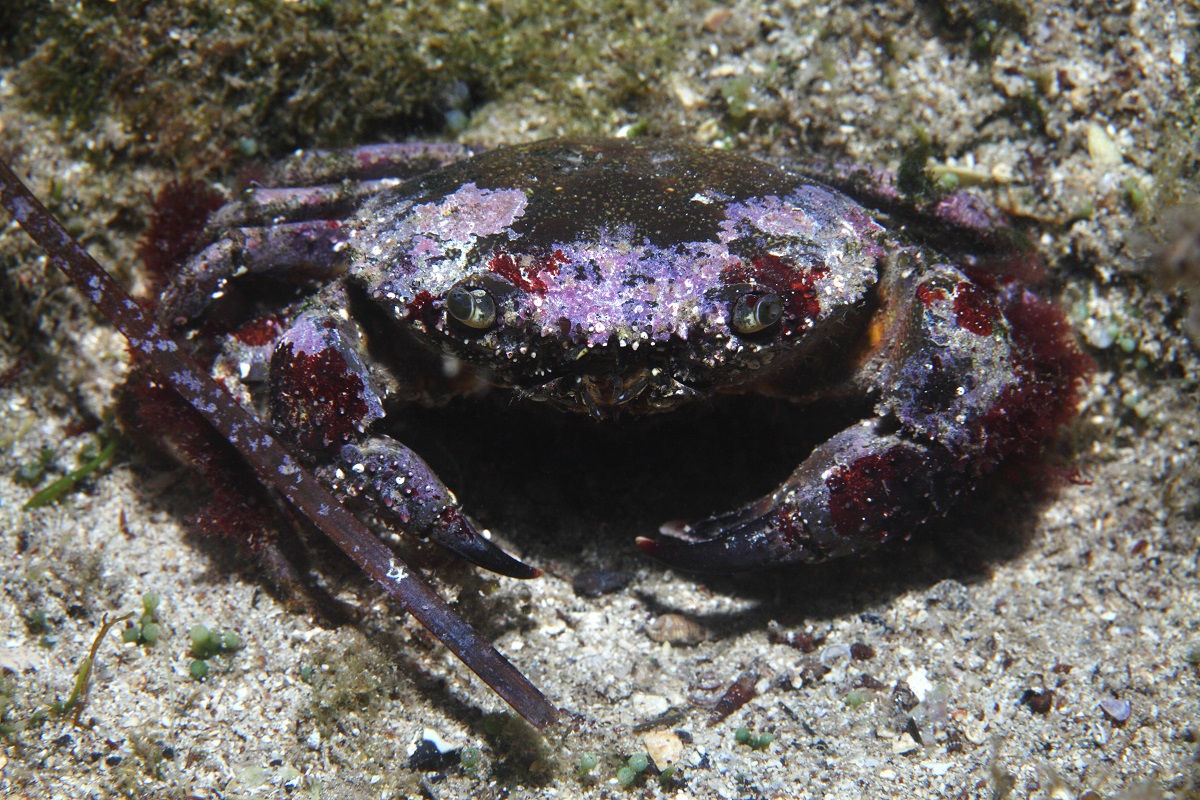If you’re first setting up your reef tank, you’re likely going to be using live rock, which has visual benefits and helps keep your aquarium healthy. Live rock can also harbor a variety of visitors: some good and some bad. They’re called hitchhikers.
One common hitchhiker is the gorilla crab. Keep reading to find all about these hairy crabs and what to do if you find one in your marine aquarium!
What is a gorilla crab?
“Gorilla crab” is a collective name for a bunch of crabs from the family Xanthidae. They’re also known as mud crabs and some of them are brightly colored, although the ones that pop up in the aquarium are usually more of a muddy color.
Gorilla crabs are often confused with emerald crabs, which do also occasionally hitchhike into the aquarium. You can tell the difference by looking at the claws: many gorilla crab species have distinctive black claw tips that are not really seen on other aquarium crab species. The emerald crab, for example, is fully green including the claw tips.
The gorilla crab grows a lot larger than most beneficial crabs, like the emerald crab (which is a champion algae eater and on the list of our favorite crab species). Mature specimens will develop a “hairy” appearance on their claws and even their carapace, which is probably what lent them their common name.
Did you know? Xanthid crabs are extremely toxic, even when cooked. Some also harbor vibrio, a species of gram-negative bacteria that can cause huge food poisoning issues and even infect open wounds. Yikes! Luckily none of this should be an issue for aquarists unless you try to eat a gorilla crab from your aquarium.
Why are gorilla crabs bad?
As we mentioned, there are various crab species that can come with your live rock or even hitch a ride on corals. Some are pretty neat, like coral crabs from the genus Tetralia which actually maintain a symbiotic relationship with corals by cleaning them.
And then there’s Xanthid gorilla crabs, whose only goal in life appears to be to wreak havoc in our reef aquariums. They grow quite large and are omnivores that will eat literally anything that they can get their claws on.
Corals, invertebrates like shrimp, starfish, anemones, clams, even small and slow fish won’t be safe with a gorilla crab around! If you spot one, it’s definitely time to mount a removal operation ASAP.
How do you remove a gorilla crab?
There aren’t really any fish or inverts that you can add to your aquarium in order to help get rid of gorilla crabs, so it’s up to you. Catching them by hand is the best option, although it can be a challenge to take these guys by surprise.
The best time to catch a gorilla crab is when the aquarium lights are off, as they are nocturnal. We’ve also read about some aquarists strobing lights at the crab to confuse it! Once the suspect is out in the open, here are some things you can do:
- Simply spear it using a sharp stick.
- Set a crab trap, like a bottle with the top half cut off and inverted. Place some bait in there to lure the crab and place the bottle near its hide. A tall jar with some bait inside can also work, as the crabs will fall in and not be able to climb out.
- Use a net if you’re quick.
- Use a claw grabber. Seriously, this can work!
- Nothing seems to work? As a last resort, you might have to pull out all rock and inspect all nooks and crannies. Some aquarists even decide to bite the bullet and do a freshwater dip.
Please note that if you’ve captured one gorilla crab, chances are there are more. Don’t rest easy just yet.
Did you know? If you have a sump, you can place the gorilla crab(s) in there to peacefully live out their days without the possibility of them wrecking your display tank.
Conclusion
A reef aquarium is a beautiful addition to any home or office, but with hitchhikers and other possible issues lurking it can be a daunting task to set up and maintain one. So why not have someone else do it? Contact FantaSEA Aquariums here with your aquarium dreams and we’ll work with you to make them come true.




